Health
& Safety
Guide
Preventing the exposure to respirable crystalline silica
during the installation of stone (natural or engineered),
ceramic benchtops, prefabricated modules and blanktops.
Note on the translation: An automatic machine translation of this document is made possible in this page, while a human translation is prepared. Use the contact form if you wish to receive a human translation of this document.
Preamble
Crystalline silica is a basic component of soil, sand, granite, quartz, and many other minerals. Respirable size particles of crystalline silica (known as RCS) may result when workers, cut, drill or grind these objects.
Respirable crystalline silica may pose a health hazard if workers are not protected properly and workplaces are not properly controlled to reduce silica dust.
Breathing in dust generated during the installation of stone (natural or engineered) or ceramic benchtops can cause serious lung diseases, including silicosis and lung cancer, because it contains respirable crystalline silica (RCS).
If there are not implemented preventive measures, workers may be exposed to RCS when cutting, trimming, grinding or polishing stone during the installation of stone (natural or engineered) or ceramic benchtops.
Uncontrolled dry cutting, trimming, grinding or polishing stone should be avoided because it exposes workers and others to large amounts of RCS.
Prior to the installation, consult the Safety Data Sheet (SDS) and “Good Practice Guide”.
The cutting, grinding or polishing of stone should be avoided without control, as it may pose a risk of overexposure to SCR for workers.
Once the product is installed, it is totally safe for its the intended use.
An installation process is not considered under control if the daily exposure is not within the limit value established by the competent labor authority. Consult the limit values established in your country.
Objective and scope
This guide is aimed at professionals who install kitchen, bath or similar countertops, whether they are prefabricated modules that have just been fabricated and installed at a customer’s house or installation of countertops fabricated in the workshop whether it is natural stone, engineered stone or ceramic materials.
Its objective is to establish preventive measures to eliminate or minimize, as far as possible, the risk of exposure to respirable cristaline silica.
Planing the installation
Minimize the need for cutting, trimming, grinding, polishing or sanding during installation by:
• Accurate measuring.
• Cutting holes and voids at the workshop before installation always if possible. Get the location and measurements prior to installation
• Completing alterations at the workshop always if possible.
• Consulting and communicating with principal contractors and clients to prevent alterations on site.
• In the case of carrying out the installation tasks of a prefabricated module, it is necessary the use of water cutting methods and when it is not possible, then use equipment with dust suppression with an efficiency of 99’9 % either indoors or outdoors.
• The water flow of the tools used in the installation in enclosed spaces should be sufficient to minimize the emission of visible dust
Minimize dust during inevitable modifications
If alterations on site are unavoidable, workers must be provided with the right tools and control measures to carry out this work safely. These include:
• Only using power tools that use water suppression or on-tool dust extraction
• Workers wearing adequate respiratory protective equipment
• Putting other measures in place to manage exposure including work practices and personal protective equipment.
• Operate and maintain the tools in accordance with the manufacturer’s instructions to minimize emissions.
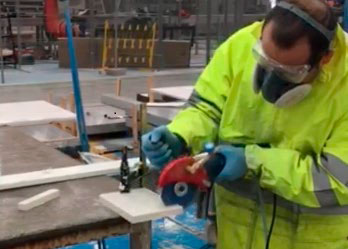
Water dust suppression
Use stone saws, grinders or polishers specifically designed for use with water suppression and make sure:
• The water feed is attached to the tool and directed at the material and/or tool to prevent visible dust during the process
• Water pressure and flow is maintained at a minimum of 0.5L/min
• Water splashes are controlled using guards, plastic flaps or brush guards.
• Consider covering furniture and other surfaces with plastic sheeting to protect them from the action of dust or water.
Note: Using a spray bottle or holding a sponge or garden hose against the blade of disc of a grinder or polisher to suppress dust does not control the risk of exposure to RSC and should be avoided. It is also dangerous to use electric power tools that are not designed to be used with water.
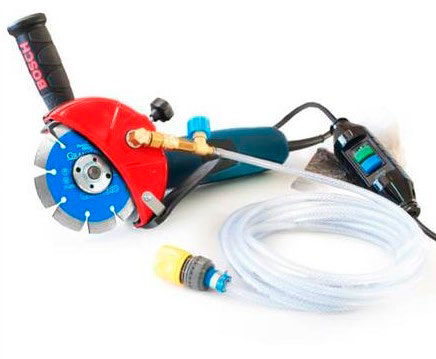
Local exhaust ventilation
Use on-tool extraction, for example, saws, grinders and polishers can be fitted with a cover and attached to a vacuum or dust extractor.
A class H Vaccum or dust extractor for highly hazarous dusts could be required according to the local legislation. H class vacuums are marked with a special label.
EN 60335-2-69 Annex AA, divides vacuum cleaners for hazardous dust into three Classes of use:
• Class L – Dust representing a moderate risk – The vacuum cleaner filter traps over 99 % of dust with a grain size of under 2 microns
• Class M – Dust representing a medium risk – The vacuum cleaner filter traps over 99.9 % of dust with a grain size of under 2 microns
• Class H – Dust representing a high risk – The vacuum cleaner filter traps over 99.995 % of dust with a grain size of under 1 micron (it includes carcinogenic dusts and dusts contaminated with carcinogens and/or pathogens)
According to the european EN 1822 proper HEPA filters for a proper extraction should be:
• H13 EU13 S EU13> = 99.99%
• H14 EU14 – EU14> = 99.999%
Place a sacrificial backer-board or spoil-board under the stone slab to increase the effectiveness of on-tool extraction. This will prevent dust from being released below the slab during cutting or trimming.
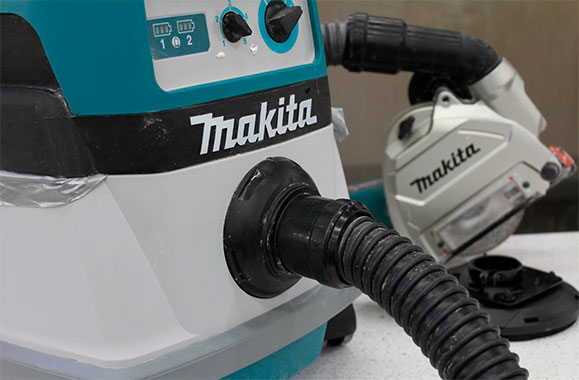
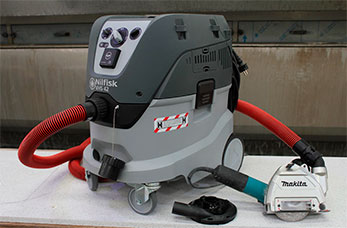
Respiratory protective equipment
Respiratory protective equipment is required in addition to using water suppression or on-tool extraction.
The level of protection of the respiratory filters must be in accordance with local regulatory requirements.
Suitable respiratory protective equipment with a particle filter must be worn:
| AUTHORITY | TYPE OF PARTICLE FILTER |
| NIOSH | From N95, R95, or P95 filter or higher level (N99, R99, P99, N100, R100, P100) according to the dust concentration. https://www.cdc.gov/niosh/npg/npgd0684.html |
| European standard EN143 | High efficiency filter P3 |
| Australian Standard AS/NZS 1716 | P1 used against mechanically generated particles P2 for use against mechanically & thermally generated particles eg metal fumes & smokes |
In any case consult the local legislation to check if any other requirement is required.
Please check applicable local law if any other specification is determined.
Use appropriate respiratory protection even when working with water as a dust reduction measure when processing stone benchtops independently on the material (natural stone, quarz, ceramics)
Workers wearing a tight-fitting respirator (a respirator that relies on a tight seal between the worker and the face piece) must pass a fit test.
Keep in mind that facial hair can make facial mask adjustment difficult and may reduce its effectiveness.
It is also strongly recommended a powered, air-purifying respirator with a tight-fitting face piece and a high-efficiency particulate filter.
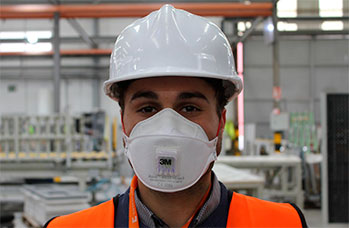
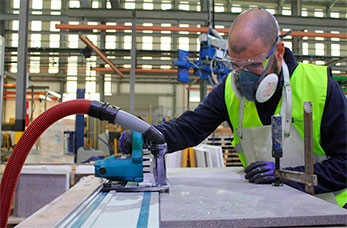
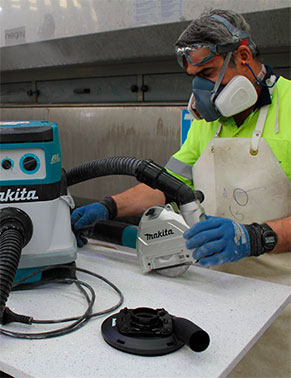

Managing and minimizing dust
Other measures to manage dust when carrying out cutting, trimming, grinding or polishing activities while onsite include:
• Working in a well-ventilated area where possible, for example outside the installation.
• Preventing exposure to others not involved with the cutting or grinding task by restricting access to the area
• Preparing and carrying out work in accordance with a safe work method statement
• Providing workers with personal protective equipment including disposable coveralls or an apron, safety boots or gumboots and hearing protection.
• Provide workers with an adequate amount of clean work clothes, including spare parts.
• Workers who handle silica dust, should wear proper chemical jumpsuit made of textile that to avoid dust absorption.
• Do not use compressed air to clean work clothes. Workers should not smoke inside the facilities.
• At the end of the work day, clean up, shower if necessary, and put on clean clothes before leaving work.
• Under no circumstances should work clothes be washed next to family clothes. It is recommended to hire a specialized laundry service.
Proper clean up at completion
Proper clean up after installation is important to avoid other people being exposed to RCS.
Keep respirators on and thoroughly clean the area, tools and equipment after finishing the job using either an H class vacuum cleaner or wet methods such as hosing, mopping or wet wiping down surfaces.
Dry sweeping methods such as brooms or using compressed air are not permitted as these methods can recirculate RCS into the air.
For more information, see:
• Good Practice Guide, for the prevention of exposure to silica dust. Cosentino.
• Safety data Sheet. Cosentino.
• Product safety label. Cosentino.
• Local legislation
For the control of exposure and the implementation of preventive measures seek the advice of a specialist in industrial hygiene.
In this guide, manufacturers’ equipment are shown:
• Cut, localized extraction and aspiration. Makita
• Provided by Unceta. https://ecommerce.unceta.es/
• Vaccum. Nilfisk. https://www.nilfisk.com/es-es/Pages/default.aspx
• Personal Protective equipment. 3M. https://www.3m.com.es/3M/es_ES/worker-health-safety-es/personal-protective-equipment/

